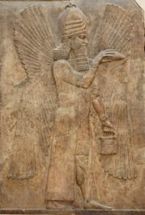Sign in or 

| Version | User | Scope of changes |
|---|---|---|
| Jun 13 2011, 3:04 AM EDT (current) | Mythical_Geek | |
| Jun 13 2011, 3:03 AM EDT | Mythical_Geek | 8 words added, 11 words deleted |
 Known as "genies" in English, Djinn (singular form Djinni) have deep roots in Arab culture. The Djinn first sprang from stories told by Indian, Persian, and Arabian storytellers and gained international fame when they appeared throughout the tales Scheherezade told in "The Thousand and One Nights". It is said that the Djinn are created from fire and can take on any form they choose-animal or human-and can be of any size (they have a human-like form and can take the shape of animals but only temporary unless it is their tribes animal protector. Most of them are hostile, although some can be friendly. It is possible for magicians or wise men and women to gain power over a Djinn and use it to perform amazing and magical tasks. Be wary, for even a friendly Djinn is unpredictable and certainly anyone who breaks an agreement with a Djinn will strongly regret it. Often Djinn take naughty pleasure in punishing people for wronging them, even unintentionally.
Known as "genies" in English, Djinn (singular form Djinni) have deep roots in Arab culture. The Djinn first sprang from stories told by Indian, Persian, and Arabian storytellers and gained international fame when they appeared throughout the tales Scheherezade told in "The Thousand and One Nights". It is said that the Djinn are created from fire and can take on any form they choose-animal or human-and can be of any size (they have a human-like form and can take the shape of animals but only temporary unless it is their tribes animal protector. Most of them are hostile, although some can be friendly. It is possible for magicians or wise men and women to gain power over a Djinn and use it to perform amazing and magical tasks. Be wary, for even a friendly Djinn is unpredictable and certainly anyone who breaks an agreement with a Djinn will strongly regret it. Often Djinn take naughty pleasure in punishing people for wronging them, even unintentionally.